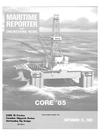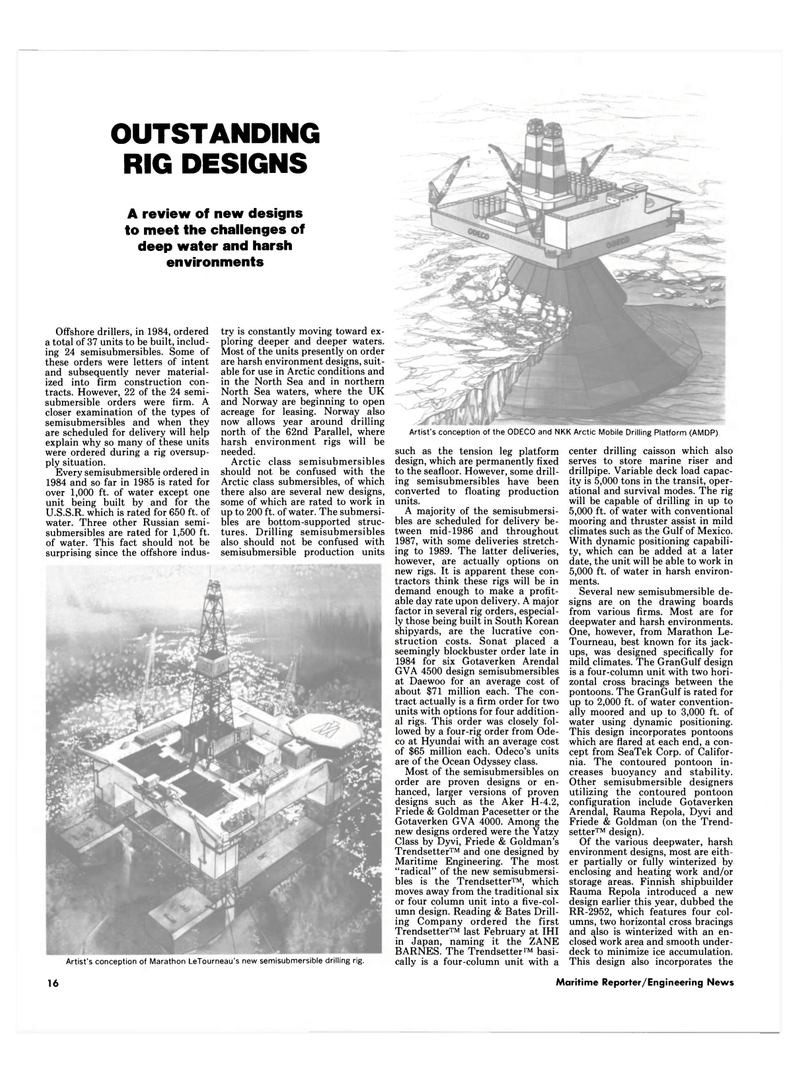
Page 14: of Maritime Reporter Magazine (September 15, 1985)
Read this page in Pdf, Flash or Html5 edition of September 15, 1985 Maritime Reporter Magazine
OUTSTANDING
RIG DESIGNS
A review of new designs to meet the challenges of deep water and harsh environments
Offshore drillers, in 1984, ordered try is constantly moving toward ex- a total of 37 units to be built, includ- ploring deeper and deeper waters, ing 24 semisubmersibles. Some of Most of the units presently on order these orders were letters of intent are harsh environment designs, suit- and subsequently never material- able for use in Arctic conditions and ized into firm construction con- in the North Sea and in northern tracts. However, 22 of the 24 semi- North Sea waters, where the UK submersible orders were firm. A and Norway are beginning to open closer examination of the types of acreage for leasing. Norway also semisubmersibles and when they now allows year around drilling are scheduled for delivery will help north of the 62nd Parallel, where explain why so many of these units harsh environment rigs will be were ordered during a rig oversup- needed. ply situation. Arctic class semisubmersibles
Every semisubmersible ordered in should not be confused with the 1984 and so far in 1985 is rated for Arctic class submersibles, of which over 1,000 ft. of water except one there also are several new designs, unit being built by and for the some of which are rated to work in
U.S.S.R. which is rated for 650 ft. of up to 200 ft. of water. The submersi- water. Three other Russian semi- bles are bottom-supported struc- submersibles are rated for 1,500 ft. tures. Drilling semisubmersibles of water. This fact should not be also should not be confused with surprising since the offshore indus- semisubmersible production units
Artist's conception of Marathon LeTourneau's new semisubmersible drilling rig. 16 such as the tension leg platform design, which are permanently fixed to the seafloor. However, some drill- ing semisubmersibles have been converted to floating production units.
A majority of the semisubmersi- bles are scheduled for delivery be- tween mid-1986 and throughout 1987, with some deliveries stretch- ing to 1989. The latter deliveries, however, are actually options on new rigs. It is apparent these con- tractors think these rigs will be in demand enough to make a profit- able day rate upon delivery. A major factor in several rig orders, especial- ly those being built in South Korean shipyards, are the lucrative con- struction costs. Sonat placed a seemingly blockbuster order late in 1984 for six Gotaverken Arendal
GVA 4500 design semisubmersibles at Daewoo for an average cost of about $71 million each. The con- tract actually is a firm order for two units with options for four addition- al rigs. This order was closely fol- lowed by a four-rig order from Ode- co at Hyundai with an average cost of $65 million each. Odeco's units are of the Ocean Odyssey class.
Most of the semisubmersibles on order are proven designs or en- hanced, larger versions of proven designs such as the Aker H-4.2,
Friede & Goldman Pacesetter or the
Gotaverken GVA 4000. Among the new designs ordered were the Yatzy
Class by Dyvi, Friede & Goldman's
Trendsetter™ and one designed by
Maritime Engineering. The most "radical" of the new semisubmersi- bles is the Trendsetter™, which moves away from the traditional six or four column unit into a five-col- umn design. Reading & Bates Drill- ing Company ordered the first
Trendsetter™ last February at IHI in Japan, naming it the ZANE
BARNES. The Trendsetter™ basi- cally is a four-column unit with a n center drilling caisson which also i serves to store marine riser and drillpipe. Variable deck load capac- n ity is 5,000 tons in the transit, oper- n ational and survival modes. The rig will be capable of drilling in up to 5,000 ft. of water with conventional mooring and thruster assist in mild t climates such as the Gulf of Mexico. With dynamic positioning capabili- i, ty, which can be added at a later i date, the unit will be able to work in 5,000 ft. of water in harsh environ- n ments.
Several new semisubmersible de- r signs are on the drawing boards - from various firms. Most are for a deepwater and harsh environments. - One, however, from Marathon Le- a Tourneau, best known for its jack- n ups, was designed specifically for il mild climates. The GranGulf design s is a four-column unit with two hori- f zontal cross bracings between the - pontoons. The GranGulf is rated for 0 up to 2,000 ft. of water convention- - ally moored and up to 3,000 ft. of - water using dynamic positioning. - This design incorporates pontoons t which are flared at each end, a con- s cept from SeaTek Corp. of Califor- nia. The contoured pontoon in- a creases buoyancy and stability. Other semisubmersible designers a utilizing the contoured pontoon !, configuration include Gotaverken e Arendal, Rauma Repola, Dyvi and e Friede & Goldman (on the Trend- y setter™ design). s Of the various deepwater, harsh y environment designs, most are eith- t er partially or fully winterized by enclosing and heating work and/or ti storage areas. Finnish shipbuilder x Rauma Repola introduced a new - design earlier this year, dubbed the RR-2952, which features four col- t umns, two horizontal cross bracings 1 and also is winterized with an en- ? closed work area and smooth under- deck to minimize ice accumulation, a This design also incorporates the
Maritime Reporter/Engineering News
Artist's conception of the ODECO and NKK Arctic Mobile Drilling Platform (AMDP)

 13
13

 15
15
